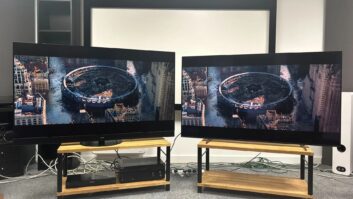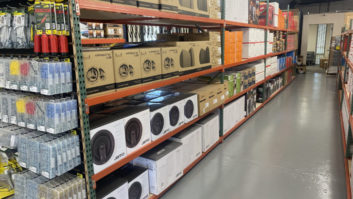LAS VEGAS — Toshihiro Sakamoto, president of Panasonic AVC Networks Company, kicked off International CES this morning in a keynote speech that outlined its strategy for high-definition technologies, and in an exclusive TWICE CES Daily interview he provided background on his speech and other industry issues.
Panasonic AVC Networks is the CE and PC manufacturing arm of parent company Matsushita Electric Industrial (MEI), and Sakamoto leads the creation and development of the company’s digital audio and video business strategies.
Among strategies, business collaborations and product introductions Sakamoto outlined in his keynote this morning:
- Panasonic’s flat-panel HDTVs are the “Digital Hearth” of the 21st century home, where family and friends will spend more time together in front of large-screen displays and using the variety of audio and video products that attach to it easily with such technology as its VIERA Link audio/video operating system. Panasonic HDTVs will now be given the VIERA brand name.
- In collaboration with Comcast a Tru2way-ready (formerly OCAP) TV expected to be available this year. The TVs require no set-top box and will be operated by only one remote. With Comcast CEO Brian Roberts, Sakamoto unveiled a portable DVR (P-DVR) called Comcast’s AnyPlay that looks like an ordinary set-top box. However, its portable device portion, consisting of an HDD and a display, can be detached from its docking station and show programming anywhere in the home, in the car or on a trip.
- With YouTube co-founder Steve Chen, Sakamoto unveiled VIERACast, a VIERA IPTV that will enable easy access to YouTube and Picasa Web Albums from Google.
- A prototype of a compact Lumix digital camera was discussed. It allows users to upload photos directly to the Picasa Web Albums through wireless hotspots without a computer.
- Plasma displays in development that have twice the brightness of previous panels were discussed.
- A prototype super-thin display that is 24.7mm, or less than one-inch in profile, giving a much greater setup flexibility was shown.
- A 150-inch advanced HD plasma display that is being shown at CES this week has the image quality that is the equivalent of nine 50-inch displays and a 2,160 by 4,096-pixel resolution, four times the resolution of the 1080p Full HD specification.
- A wireless 1080p Full HD transmission system developed by Panasonic with SiBEAM was discussed. It can transmit uncompressed 1080p Full HD content wirelessly with no deterioration in quality that enables interconnected equipment to be controlled by one remote.
Sakamoto spoke with TWICE CES Daily about the background on Panasonic’s thinking concerning these strategic decisions and other issues.
TWICE: How did you come up with the “Digital Hearth”?
Sakamoto: I didn’t come up with it. I spoke with Bob Greenberg [Panasonic corporate brand marketing group VP for North America] and we talked about it. Thinking it could be a phase for a 21st century fireplace for Americans … to bring the family back in front of the TV. Just like families gathered in front of the fireplace in ancient days.
TWICE: Are you in discussions with other cable companies to offer them your Tru2way and portable DVR technologies?
Sakamoto: Tru2way is not just for Comcast. We are discussing the use of Tru2way and the portable DVR technologies with other cable companies.
TWICE: What advantages will the use of VIERA in your flat panel line provide in the U.S.?
Sakamoto: We began to use the VIERA name in 2003 because it stands for “Vision Era.” Now we are in a networking era with connectable products. There is a new “Vision Era” in Europe and Japan and we have promoted VIERA as a brand. Panasonic is known for all types of CE products. VIERA is a platform that can connect products in a network. In Japan we checked sales of products that can be connected to a TV and VIERA TVs grew in sales by 26 percent in one month. The same boost came to Europe.
TWICE: Why a 150-inch plasma? Is it just a technology statement or a viable retail and/or professional product?
Sakamoto: Consumers are the most important. With our 103-inch from last year we sold 3,000 units. Planet Hollywood here in Las Vegas has 10. We also want to show the ability of plasma display panels that provide 2,160 by 4,096-pixel resolution, four times the resolution of the 1080p Full HD specification.
TWICE: Do you have an exclusive deal with Google and YouTube for content? How will this improve your brand position in flat-screen TV?
Sakamoto: We are a pioneer in this area, but we don’t want [that content] to be restricted to us. I’m sure they will open it to others. It is important for the industry to grow. For us it will enhance our image as a leader in HDTV, a leader in home networking that is centered on TV. You have to acknowledge that unless TVs sell other things such as audio and other categories, even home security devices and technology.
TWICE: Plasma has been the centerpiece of Panasonic’s HD strategy from the beginning. Will the company be comfortable it is the only widely distributed plasma TV maker in two or three years?
Sakamoto: In the next five to seven years we can compete with plasma TV vs. other HD such as OLED and LCD. It is true that LCD is expanding its screen size. But we feel that plasma enables much larger screen sizes with finer resolution. There are lots of areas of growth where we can improve plasma. Even if LCD continues to increase in market share, plasma can compete.
TWICE: When will Panasonic begin to reap the benefits from its co-development deal with Hitachi and Canon on OLED and LCD?
Sakamoto: That should start beginning in 2010. As you know we already have LCD. The alliance is building a new factory that will start running in early 2010. LCD panel supply for TV is short, because some manufacturers gear production from TVs to PC displays and other depending upon market conditions. We must have a long-term stable supply source.
For OLED we believe that it is important to have your own facility to develop product from the beginning. We have not disclosed when we would introduce an OLED but we don’t believe the format will be full-fledged category in bigger screen sizes, such as 32 inches and above, until 2012 to 2014.
TWICE: What is your initial reaction to Warner Home Video becoming an exclusive backer of Blu-ray?
Sakamoto: We appreciate and welcome their decision. This will accelerate the end of the format competition. In Japan that competition has already been completed.













